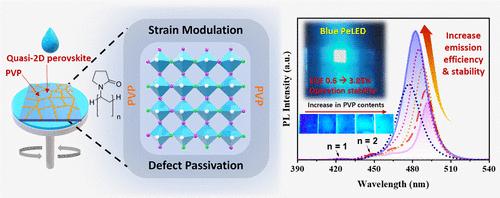通过应变调制路易斯碱添加增强蓝致准二维钙钛矿的发射效率和稳定性
IF 8.2
2区 材料科学
Q1 MATERIALS SCIENCE, MULTIDISCIPLINARY
引用次数: 0
摘要
由于缺陷引起的非辐射复合、卤化物离子迁移和相偏析,基于金属卤化物钙钛矿实现稳定高效的蓝色发光二极管(led)仍然具有挑战性。本研究展示了一种有效的策略,通过添加聚乙烯吡咯烷酮(PVP)作为路易斯碱添加剂来提高蓝色发射准二维(2D)钙钛矿薄膜的发射效率和稳定性。PVP与a位阳离子和Pb原子强烈相互作用,抑制卤化物迁移,钝化晶界,湮灭缺陷。它在钙钛矿层内调节应力的能力,特别是在电应力下减轻相偏析的能力,尤其值得注意。结果表明,pvp处理的准二维钙钛矿薄膜的光致发光量子产率达到32%,即使在高温下也能增强蓝色发射稳定性。经过pvp处理的准二维钙钛矿蓝色LED的发射效率比原始LED提高了6.42倍,在高工作电压下具有优异的颜色稳定性,电致发光峰移可以忽略不计。这些改进突出了PVP在缺陷钝化和应力调制中的双重作用,显著提高了器件的运行稳定性。虽然发光效率仍然不高,但PVP处理提高了颜色稳定性,延长了使用寿命,这是实现稳定的钙钛矿基蓝色led的关键一步。本文章由计算机程序翻译,如有差异,请以英文原文为准。

Enhanced Emission Efficiency and Stability of Blue-Emitting Quasi-2D Perovskites via Strain-Modulating Lewis Base Addition
Achieving stable and efficient blue light-emitting diodes (LEDs) based on metal halide perovskites has remained challenging due to defect-induced nonradiative recombination, halide ion migration, and phase segregation. This study demonstrates an effective strategy to enhance emission efficiency and stability in blue-emitting quasi-two-dimensional (2D) perovskite films by incorporating polyvinylpyrrolidone (PVP) as a Lewis base additive. PVP interacts strongly with A-site cations and Pb atoms, suppressing halide migration, passivating grain boundaries, and annihilating defects. Its ability to modulate stress within the perovskite layer, especially mitigating phase segregation under electrical stress, is particularly notable. As a result, the PVP-treated quasi-2D perovskite thin films exhibited a photoluminescence quantum yield of 32% and enhanced blue emission stability even at elevated temperatures. The blue LED with PVP-treated quasi-2D perovskites exhibited 6.42 times improved emission efficiency compared to the pristine one, demonstrating superior color stability with negligible electroluminescence peak shifts under high operating voltages. These improvements highlight the dual role of PVP in defect passivation and stress modulation, which significantly enhances the operational stability of the devices. While the emission efficiency remains modest, the improved color stability and extended operational lifetime achieved by PVP treatment represent a critical step toward the practical realization of stable perovskite-based blue LEDs.
求助全文
通过发布文献求助,成功后即可免费获取论文全文。
去求助
来源期刊

ACS Applied Materials & Interfaces
工程技术-材料科学:综合
CiteScore
16.00
自引率
6.30%
发文量
4978
审稿时长
1.8 months
期刊介绍:
ACS Applied Materials & Interfaces is a leading interdisciplinary journal that brings together chemists, engineers, physicists, and biologists to explore the development and utilization of newly-discovered materials and interfacial processes for specific applications. Our journal has experienced remarkable growth since its establishment in 2009, both in terms of the number of articles published and the impact of the research showcased. We are proud to foster a truly global community, with the majority of published articles originating from outside the United States, reflecting the rapid growth of applied research worldwide.
 求助内容:
求助内容: 应助结果提醒方式:
应助结果提醒方式:


